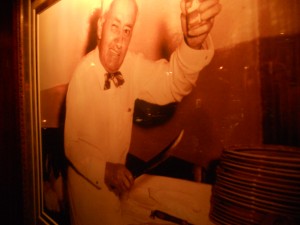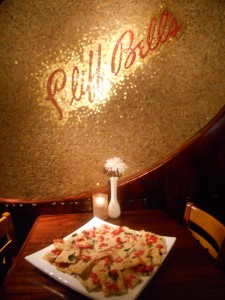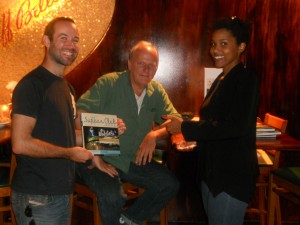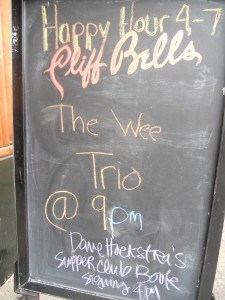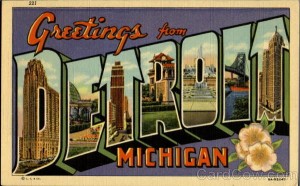
I came into Detroit a night before my book signing at Cliff Bell’s because I like the city.
Things seem so rock bottom, I feel a new slate of creative expression emerging–even though the vapor rising from the grates along Woodward Avenue still gives Detroit an apocalyptic feel.
You can’t go far in downtown Detroit without someone mentioning the city’s bankruptcy. It’s the same way everyone in Chicago harps about the Bears.
After catching a Tigers game I was sitting at a bar next to the Fox Theater.
A stranger looked me in the eye and asked, “Is this city worth saving?”
I’ve been from Fairbanks, Alaska to the Guatemalan fishing village of La Barrona (pop. 900) where I spent a New Year’s Eve on a mattress on a dirt floor. Adriana and I still question if we saw a black rat scurry across the floor to bring in the new year.
But no one has asked me, “Is this city worth saving?” on any visit.
I could not answer that question objectively about Detroit.
“Of course,” I said over a Blue Moon at the Detroit bar. I elaborated that maybe Detroit should no longer think of itself as a major metropolitan area but as a boutique urban destination like Baltimore (pop. 619,000).
But what do I know?
I do not know what it is like to live day to day in Detroit.
“It’s daunting,” said Paul Howard, one of the founding partners who brought Cliff Bell’s back to life in downtown Detroit. I had told him about my previous evening’s encounter. He said, “It’s tough getting things done daily.”
Howard, 39, is a Detroit native.
I loved Cliff Bell’s history and wanted to veer off the predictable rural supper club path to include them in my book.
Howard and I had a couple long talks while I was researching the book. I closed the Cliff Bell’s chapter with his remark about Detroit that still gives me chills. He reflected, “Maybe a good analogy would be the people who held out in the Dust Bowl. They had the same sense of pride and would be happy to tell you about their lives.
“I guess I’m one of them.”
You find that in Detroit.
I go to Detroit a couple times a year and I’ve consistently noticed the majority of people make an extra effort to talk to you, give you directions or share a story. And there is no argument that Detroit’s Eastern Market is more exciting and cross cultural than any Farmer’s Market in Chicago. After all, I found Mountain Dew jelly at the the Eastern Market.
The book signing turnout at Cliff Bell’s was unlike any other of the half-dozen appearances I did this summer. There weren’t many older supper club regulars.
Cliff Bell’s has been reinvented into an upscale urban destination. They are using Chicago’s iconic Green Mill night club as a dark, visual template for live music. On a Thursday evening I saw Tigers fans (Cliff Bell’s is just a couple blocks from the balllpark) and Wayne State students. Alissa Jenkins is studying journalism at Wayne State. Her friend Steve Duttine is a photographer from England who was documenting Detroit.
We talked a lot about the presumed deaths of Detroit and print journalism.
Thanks to my friend Susan Whitall for this comprehensive write- up in the Detroit News.
Find her 2011 book “Fever: Little Willie John, A Fast Life, Mysterious Death and the Birth of Soul (Titan Books). The former Creem editor does justice to the precursor to James Brown and Stevie Wonder.
Grits ain’t groceries.
So when you go travel to Detroit, and please do, also find a room at the Inn on Ferry Street.
Ironically, the first time I stayed at Inn on Ferry was when I went to see Bruce Springsteen’s “Wrecking Ball” tour last spring in suburban Auburn Hills. The Inn on Ferry is actually four restored Victorian homes and two carriage houses just north of downtown Detroit. Both times I have stayed at Inn on Ferry I was in The Scott House, built in 1886 by Detroit architect John Scott. Locally roasted Great Lakes coffee is served 24/7, which is always a plus for me.
The Inn was developed by Midtown Detroit, a non-profit planning and economic development agency. The group partnered with the Detroit Institute of the Arts (DIA), which owned the property and had been using some of the homes for storage. The Inn opened about a week after 9/11. All the buildings comprising the Inn are on the local, state and the National Register of Historic Places.
After the Tigers game and the Blue Moon beer I stopped for a sandwich at the Magic Stick on Woodward. I had called the Inn on Ferry for a briefing on where to turn. It was just before midnight when I rolled into The Inn. A parking attendant was waiting for me on the driveway. I was not a stranger in this struggling town.
Sometimes the wounded heart is the most passionate heart.
